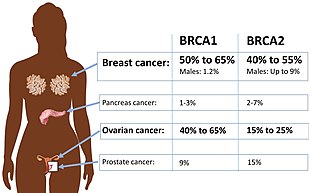
Back طفرة BRCA Arabic BRCA-mutation Danish Μετάλλαξη BRCA Greek Mutación BRCA Galician מוטציית BRCA HE Mutasi BRCA ID BRCA erfðabreyta Icelandic Mutação BRCA Portuguese BRCA Turkish BRCA突變 Chinese
| BRCA mutation | |
|---|---|
 | |
| Absolute risk of cancers in BRCA1 or BRCA2 mutation.[1] | |
| Specialty | Medical genetics |
A BRCA mutation is a mutation in either of the BRCA1 and BRCA2 genes, which are tumour suppressor genes. Hundreds of different types of mutations in these genes have been identified, some of which have been determined to be harmful, while others have no proven impact. Harmful mutations in these genes may produce a hereditary breast–ovarian cancer syndrome in affected persons. Only 5–10% of breast cancer cases in women are attributed to BRCA1 and BRCA2 mutations (with BRCA1 mutations being slightly more common than BRCA2 mutations), but the impact on women with the gene mutation is more profound.[2] Women with harmful mutations in either BRCA1 or BRCA2 have a risk of breast cancer that is about five times the normal risk, and a risk of ovarian cancer that is about ten to thirty times normal.[3] The risk of breast and ovarian cancer is higher for women with a high-risk BRCA1 mutation than with a BRCA2 mutation. Having a high-risk mutation does not guarantee that the woman will develop any type of cancer, or imply that any cancer that appears was actually caused by the mutation, rather than some other factor.
High-risk mutations, which disable an important error-free DNA repair process (homology directed repair), significantly increase the person's risk of developing breast cancer, ovarian cancer and certain other cancers. Why BRCA1 and BRCA2 mutations lead preferentially to cancers of the breast and ovary is not known, but lack of BRCA1 function seems to lead to non-functional X-chromosome inactivation. Not all mutations are high-risk; some appear to be harmless variations. The cancer risk associated with any given mutation varies significantly and depends on the exact type and location of the mutation and possibly other individual factors.
Mutations can be inherited from either parent and may be passed on to both sons and daughters. Each child of a genetic carrier, regardless of sex, has a 50% chance of inheriting the mutated gene from the parent who carries the mutation. As a result, half of the people with BRCA gene mutations are male, who would then pass the mutation on to 50% of their offspring, male or female. The risk of BRCA-related breast cancers for men with the mutation is higher than for other men, but still low.[4] However, BRCA mutations can increase the risk of other cancers, such as colon cancer, pancreatic cancer, and prostate cancer.
Methods to diagnose the likelihood of a patient with mutations in BRCA1 and BRCA2 getting cancer were covered by patents owned or controlled by Myriad Genetics.[5][6] Myriad's business model of exclusively offering the diagnostic test led to Myriad growing from being a startup in 1994 to being a publicly traded company with 1200 employees and about $500 million in annual revenue in 2012;[7] it also led to controversy over high prices and the inability to get second opinions from other diagnostic labs, which in turn led to the landmark Association for Molecular Pathology v. Myriad Genetics lawsuit.[8]
Biallelic and homozygous inheritance of a BRCA gene leads to a severe form of Fanconi anemia, and is embryonically lethal in the majority of the cases.
- ^ Cite error: The named reference
Petrucelli_1998was invoked but never defined (see the help page). - ^ Yan H (14 May 2013). "What's the gene that led to Angelina Jolie's double mastectomy?". Health. CNN.
- ^ "BRCA1 and BRCA2: Cancer Risk and Genetic Testing". National Cancer Institute. 29 May 2009.
- ^ Cite error: The named reference
10yearriskwas invoked but never defined (see the help page). - ^ US5747282
- ^ US5837492
- ^ Myriad Investor Page—see "Myriad at a glance" Archived 18 October 2012 at the Wayback Machine accessed October 2012
- ^ Schwartz J (12 May 2009). "Cancer Patients Challenge the Patenting of a Gene". The New York Times.